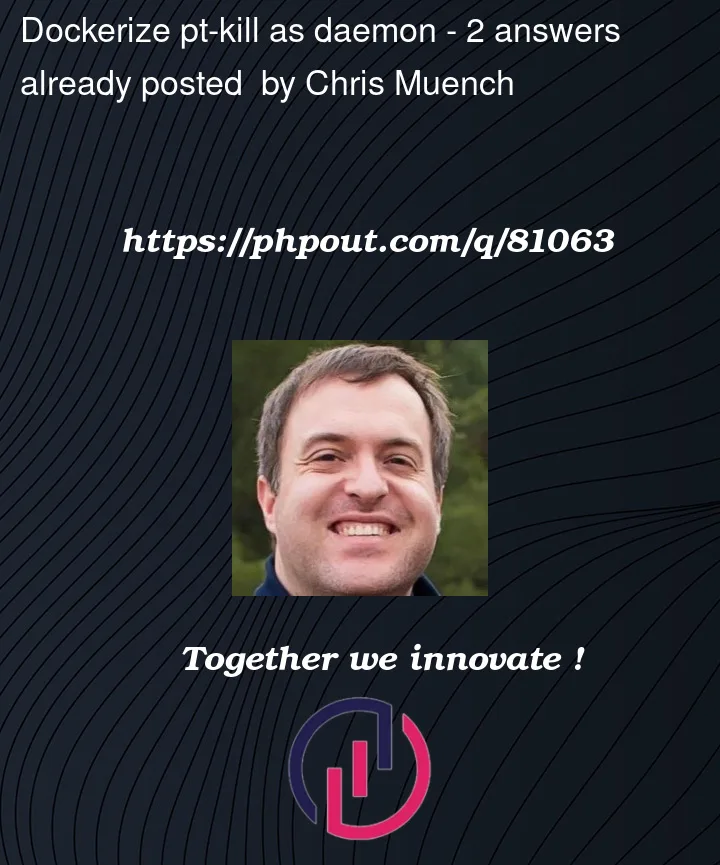I am coverting my infra. to containers. I have a couple daemons that right now live in rc.local but I want to do this the docker way
here are the commands:
sudo /usr/bin/pt-kill --rds --match-command Query --victims all --match-user phppoint --daemonize --busy-time 30 --kill --print h=db-1,u=master,p=password,P=3306
sudo /usr/bin/pt-kill --rds --match-command Query --victims all --match-user phppoint --daemonize --busy-time 30 --kill --print h=db-2,u=master,p=password,P=3306
What is the proper way to do this via docker?




2
Answers
As mentioned in "How to use Percona Toolkit in a Docker container?", you might need to build your own image, starting from this Dockerfile
The thread mentions The docker image under perconalab (
perconalab/percona-toolkit) seems to be the same but isn’t.Maybe
perconalab/pmm-clientis a better option.AFAIK Percona doesn’t provide an official Docker image for the toolkit but, as suggested by @VonC in his answer as well, you could try using the
Dockerfileprovided in their Github repository, it will give you a base image with the necessary tools installed, includingpt-kill. To runpt-kill, you will need to provide the necessary command when running your docker container, or extend the image by including aCMDin yourDockerfilewith the necessary information. For reference, I build the aforementionedDockerfile:And was able to using
pt-killagainst a local docker based MySQL database running the following command from my terminal:I tested it running the following sentence from MySQL Workbench:
Which produces the following output from
pt-kill:The way in which this container could be run will depend on your actual infrastructure.
I assume by the existence of the
--rdsflag in your command that you are connecting to an Amazon RDS instance.You have many ways for running containers in AWS (see for instance this blog entry, for naming some of them).
In your use case probably the way to go would be using ECS running over EC2 compute instances (the Fargate serverless option doesn’t make sense this time), or even EKS, although I think it would be overkill.
You could provision an EC2 instance, install
docker, and deploy locally your containers as well, but probably it would a less reliable solution than using ECS.Just in case, and the same applies if running your containers from an on-premise machine, you will need to launch the containers at startup. In my original answer I stated that in the end you probably will need to use
rc.localorsystemdto run your container, perhaps by invoking an intermediate shell script, that will launch the actual container usingdocker run, but thinking about it I realized that the dependency with the docker daemon – it should be running to run your container – could be a problem. Although some kind of automation could be required, consider running your container indicatingalwaysorunless-stoppedas the--restartpolicy.As you suggested, you could use
docker-composefor defining both daemons too. The followingdocker-compose.yamlfile could be of help:We are building the docker image in compose itself: it assumes the existence of the mentioned Percona toolkit
Dockerfilein the same directory in which thedocker-compose.yamlfile is located. You can build the image and publish it to ECR or wherever you see fit and use it in yourdocker-compose.yamlfile as an alternative if you prefer:In order to reuse as much code as possible, the example uses
extensionfragments, although of course you can repeat the service definition if necessary.Note as well that we get rid of the
--daemonizeoption in the command definition.In any case, you will need to configure your security groups to allow communication with the RDS database.
Having said all that, in my opinion, your current solution is a good one: although especially using ECS could be a valid solution, probably provisioning a minimal EC2 instance with the necessary tools installed could be a cheaper and simple option than running them in containers.